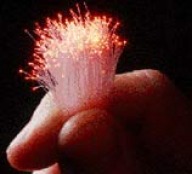How Does a T1 Line Work?

A phone company’s normal business or residential line, which most of us know about, conveys your voice as analog signal through a pair of copper wires where it is transported with. This can communicate information or any data at about 30 kilobits per second (30,000 bits per second) when you’d use a normal modem through this line.
Almost all voice traffic is passaged as digital instead of analog signals by the phone company. If your analog line is sampled at 8,000 times per second at 8-bit resolution (64,000 bits per second), it’ll be changed and converted to a digital signal. Nowadays, fiber optic lines are commonly used in transmitting almost all digital data and the phone company recognizes the use and capacity of such line by labelling it out through different designations.
You should know that a T1 line is a fiber optic line or copper line. So if you do know this fact, you’d know easily if you have a T1 on your office. T1 lines can transmit data at a rate of 1.544 megabits per second and 24 digitized voice channels. If it’s used for phone transactions and the likes, it goes directly into the office’s phone system and it’s plugged into the network’s router if it’s transmitting data from computers or laptops.
Moreover, this line can transport about 192, 000 bytes per second. If compared to a normal residential modem, that’s approximately sixty times more data being transmitted. Also, compared to an analog modem, T1 is greatly more reliable. It can accommodate a large number of users at a time. One possible problem it could give is that it couldn’t support all of them if they’re downloading MP3 files or pictures and video files concurrently. Yet this just rarely happens so everyone can still do research, do their designated works or tasks, do social networking and the likes at the same time.
A T1 line can be pricey and this could range from $1,000 and $1,500 per month. The total cost is the combination of ISP and the phone company charge fees and a web server is required to be connected from its other end.
T1 is not merely enough for a very large company. So here’s a list that shows some of the common line designations:
• DS0 - 64 k ilobits per second
• ISDN - Two DS0 lines plus signaling (16 kilobytes per second), or 128 kilobits per second
• T1 - 1.544 megabits per second (24 DS0 lines)
• T3 - 43.232 megabits per second (28 T1s)
• OC3 - 155 megabits per second (84 T1s)
• OC12 - 622 megabits per second (4 OC3s)
• OC48 - 2.5 gigabits per seconds (4 OC12s)
• OC192 - 9.6 gigabits per second (4 OC48s)
Almost all voice traffic is passaged as digital instead of analog signals by the phone company. If your analog line is sampled at 8,000 times per second at 8-bit resolution (64,000 bits per second), it’ll be changed and converted to a digital signal. Nowadays, fiber optic lines are commonly used in transmitting almost all digital data and the phone company recognizes the use and capacity of such line by labelling it out through different designations.
You should know that a T1 line is a fiber optic line or copper line. So if you do know this fact, you’d know easily if you have a T1 on your office. T1 lines can transmit data at a rate of 1.544 megabits per second and 24 digitized voice channels. If it’s used for phone transactions and the likes, it goes directly into the office’s phone system and it’s plugged into the network’s router if it’s transmitting data from computers or laptops.
Moreover, this line can transport about 192, 000 bytes per second. If compared to a normal residential modem, that’s approximately sixty times more data being transmitted. Also, compared to an analog modem, T1 is greatly more reliable. It can accommodate a large number of users at a time. One possible problem it could give is that it couldn’t support all of them if they’re downloading MP3 files or pictures and video files concurrently. Yet this just rarely happens so everyone can still do research, do their designated works or tasks, do social networking and the likes at the same time.
A T1 line can be pricey and this could range from $1,000 and $1,500 per month. The total cost is the combination of ISP and the phone company charge fees and a web server is required to be connected from its other end.
T1 is not merely enough for a very large company. So here’s a list that shows some of the common line designations:
• DS0 - 64 k ilobits per second
• ISDN - Two DS0 lines plus signaling (16 kilobytes per second), or 128 kilobits per second
• T1 - 1.544 megabits per second (24 DS0 lines)
• T3 - 43.232 megabits per second (28 T1s)
• OC3 - 155 megabits per second (84 T1s)
• OC12 - 622 megabits per second (4 OC3s)
• OC48 - 2.5 gigabits per seconds (4 OC12s)
• OC192 - 9.6 gigabits per second (4 OC48s)
